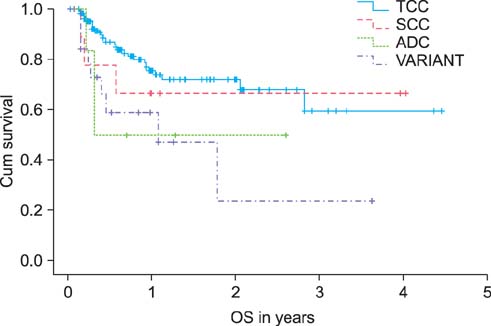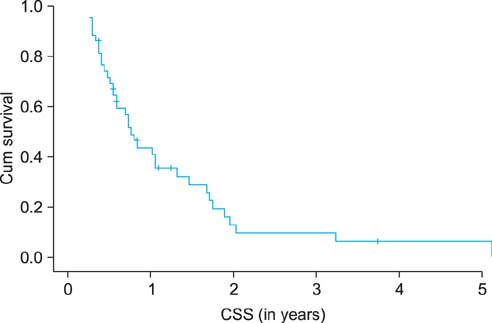Korean J Urol.
2014 Jun;55(6):385-389. 10.4111/kju.2014.55.6.385.
Impact of Histopathological Variant on the Outcome of Patients Treated by Radical Cystectomy
- Affiliations
-
- 1Department of Surgery, Aga Khan University, Karachi, Pakistan. hammad.ather@aku.edu
- KMID: 1885616
- DOI: http://doi.org/10.4111/kju.2014.55.6.385
Abstract
- PURPOSE
It is well established that muscle-invasive urothelial carcinoma (UC) has a marked propensity for divergent differentiation, a fact that has significant diagnostic, prognostic, and therapeutic implications. This work is designed to assess the impact of different histopathologic variants of bladder cancer on morbidity and mortality in patients undergoing radical cystectomy (RC) as compared to the impact in patients with conventional UC.
MATERIALS AND METHODS
We reviewed records of 201 patients treated with RC and pelvic lymph node dissections. Demographics as well as clinico-pathologic parameters, including histopathological variant, tumor stage, and nodal status, were reviewed. Multivariate analyses were used to evaluate these parameters for overall survival (OS). Kaplan-Meier curves for overall and cancer-specific survival were plotted.
RESULTS
The majority of patients were male (84%), and the mean age was 61+/-13.1 years (range, 27-87 years). The mean follow-up was 67 months (range, 6-132 months). A histological variant of UC tumor was found in 19 patients (11%). The OS was 55%, and the cancer-specific survival was 35%. The histopathologic variance showed significant impact on morbidity and mortality (p=0.02 and p=0.05, respectively). Patients with divergent histopathology of bladder tumor have poorer survival than do those with UC in a multivariate analysis.
CONCLUSIONS
The pathologic stages at RC and lymph node involvement are predictors for OS. Because of its aggressive nature, histopathologic variance is an independent risk factor determining the outcome in terms of both morbidity and mortality.
MeSH Terms
Figure
Reference
-
1. Jemal A, Murray T, Ward E, Samuels A, Tiwari RC, Ghafoor A, et al. Cancer statistics, 2005. CA Cancer J Clin. 2005; 55:10–30. Erratum in: CA Cancer J Clin 2005;55:259.2. Eble JN, Young RH. Carcinoma of the urinary bladder: a review of its diverse morphology. Semin Diagn Pathol. 1997; 14:98–108.3. Zhai QJ, Black J, Ayala AG, Ro JY. Histologic variants of infiltrating urothelial carcinoma. Arch Pathol Lab Med. 2007; 131:1244–1256.4. Amin MB, Murphy WM, Reuter VE, Ro JY, Ayala AG, Weiss MA, et al. A symposium on controversies in the pathology of transitional cell carcinomas of the urinary bladder. Part I. Anat Pathol. 1996; 1:1–39.5. Perez-Montiel D, Hes O, Michal M, Suster S. Micropapillary urothelial carcinoma of the upper urinary tract: Clinicopathologic study of five cases. Am J Clin Pathol. 2006; 126:86–92.6. Koga F, Fujii Y, Masuda H, Numao N, Yokoyama M, Ishioka J, et al. Pathology-based risk stratification of muscle-invasive bladder cancer patients undergoing cystectomy for persistent disease after induction chemoradiotherapy in bladder-sparing approaches. BJU Int. 2012; 110(6 Pt B):E203–E208.7. Yafi FA, Aprikian AG, Fradet Y, Chin JL, Izawa J, Rendon R, et al. Surveillance guidelines based on recurrence patterns after radical cystectomy for bladder cancer: the Canadian Bladder Cancer Network experience. BJU Int. 2012; 110:1317–1323.8. Eble JN, Sauter G, Epstein JI, Sesterhenn IA. World Health Organization classification of tumours. Pathology and genetics of tumors of the urinary system and male genital organs. Lyon: IARC Press;2004.9. Amin MB. Histological variants of urothelial carcinoma: diagnostic, therapeutic and prognostic implications. Mod Pathol. 2009; 22:Suppl 2. S96–S118.10. Grossman HB, Natale RB, Tangen CM, Speights VO, Vogelzang NJ, Trump DL, et al. Neoadjuvant chemotherapy plus cystectomy compared with cystectomy alone for locally advanced bladder cancer. N Engl J Med. 2003; 349:859–866. Erratum in: N Engl J Med 2003;349:1880.11. Scosyrev E, Ely BW, Messing EM, Speights VO, Grossman HB, Wood DP, et al. Do mixed histological features affect survival benefit from neoadjuvant platinum-based combination chemotherapy in patients with locally advanced bladder cancer? A secondary analysis of Southwest Oncology Group-Directed Intergroup Study (S8710). BJU Int. 2011; 108:693–699.
- Full Text Links
- Actions
-
Cited
- CITED
-
- Close
- Share
- Similar articles
-
- Impact of Histologic Variants of Bladder Cancer on Oncology Outcome After Radical Cystectomy
- The Impact of Pelvic Lymphadenectomy on the Survival of Patients Who Underwent Radical Cystectomy for Transitional Cell Carcinoma of the Bladder
- Radical Cystectomy with Pelvic Lymphadenectomy in Bladder Tumor: Review of 14 Cases
- A Fistula between Ileal Conduit and Iliac Artery after Radical Cystectomy with Ileal Conduit Urinary Diversion
- Robot-Assisted Laparoscopic Radical Cystectomy



